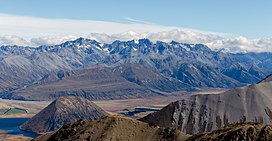| Arrowsmith Range | |
|---|---|
 | |
| Highest point | |
| Peak | Mount Arrowsmith |
| Elevation | 2,781 m (9,124 ft) |
| Coordinates | 43°21′25.5″S 170°58′38″E / 43.357083°S 170.97722°E / -43.357083; 170.97722 |
| Dimensions | |
| Length | 10 km (6.2 mi) |
| Geography | |
| Country | New Zealand |
| Region | Canterbury region |
| District | Ashburton District |
The Arrowsmith Range is a mountain range in the South Island of New Zealand. The range runs from southwest to northeast, parallel to the main ranges of the Southern Alps / Kā Tiritiri o te Moana. At the northeastern end, the range terminates at Jagged Peak (2,706 metres (8,878 ft)), whence a ridge connects to the Jollie Range. The lower Potts Range is a continuation at the southwestern end of the range. The highest point on the range is Mount Arrowsmith (2,781 metres (9,124 ft)).
It is believed that the range was named in honour of John Arrowsmith, the 19th century British cartographer.
Peaks
Named peaks from northwest to southeast
| Name | Elevation (m) |
|---|---|
| Prop Peak | 2408 |
| Jagged Peak | 2706 |
| Upham Peak | 2705 |
| Tower Peak | 2690 |
| The Twins | 2564 |
| Couloir Peak | 2642 |
| Mount Arrowsmith | 2781 |
| Ashburton Peak | 2359 |
| Hakatere Peak | 2298 |
| South Peak | 2343 |
Rivers
The northwest side of the range is drained by the Lawrence River, a tributary of the Rangitata River, and the southeast side by the Ashburton River South Branch / Hakatere and the Cameron River which flows to Lake Heron.
Glaciers
Although the peaks do not have permanent ice or snow, there are a number of permanent snowfields and glaciers on the range:
- Jagged Glacier
- Douglas Glacier
- Cameron Glacier
- South Cameron Glacier
- Ashburton Glacier
Climate
| Climate data for Upper Rakaia, elevation 1,752 m (5,748 ft), (1991–2020) | |||||||||||||
|---|---|---|---|---|---|---|---|---|---|---|---|---|---|
| Month | Jan | Feb | Mar | Apr | May | Jun | Jul | Aug | Sep | Oct | Nov | Dec | Year |
| Mean daily maximum °C (°F) | 11.0 (51.8) |
11.4 (52.5) |
10.0 (50.0) |
7.4 (45.3) |
5.1 (41.2) |
3.3 (37.9) |
2.2 (36.0) |
2.8 (37.0) |
3.8 (38.8) |
5.1 (41.2) |
6.6 (43.9) |
9.0 (48.2) |
6.5 (43.7) |
| Daily mean °C (°F) | 7.4 (45.3) |
7.9 (46.2) |
6.5 (43.7) |
4.0 (39.2) |
2.0 (35.6) |
−0.1 (31.8) |
−1.3 (29.7) |
−0.9 (30.4) |
0.0 (32.0) |
1.5 (34.7) |
3.1 (37.6) |
5.6 (42.1) |
3.0 (37.4) |
| Mean daily minimum °C (°F) | 3.8 (38.8) |
4.4 (39.9) |
3.0 (37.4) |
0.5 (32.9) |
−1.1 (30.0) |
−3.5 (25.7) |
−4.8 (23.4) |
−4.6 (23.7) |
−3.7 (25.3) |
−2.1 (28.2) |
−0.5 (31.1) |
2.1 (35.8) |
−0.5 (31.0) |
| Average rainfall mm (inches) | 285.4 (11.24) |
183.9 (7.24) |
177.2 (6.98) |
215.1 (8.47) |
218.8 (8.61) |
131.3 (5.17) |
87.0 (3.43) |
91.1 (3.59) |
143.4 (5.65) |
206.6 (8.13) |
216.9 (8.54) |
244.3 (9.62) |
2,201 (86.67) |
| Source: CliFlo | |||||||||||||
References
- ^ New Zealand 1:50000 Topographic Map Series sheet BX18 – Whitcombe Pass
- Wises New Zealand Guide, 7th Edition 1979 p 13
- "CliFlo – National Climate Database : Upper Rakaia Ews". NIWA. Retrieved 10 May 2024.
This Canterbury Region-related geography article is a stub. You can help Misplaced Pages by expanding it. |